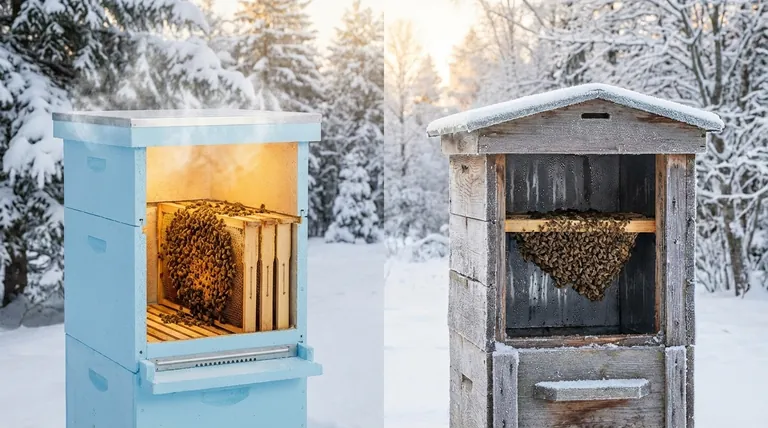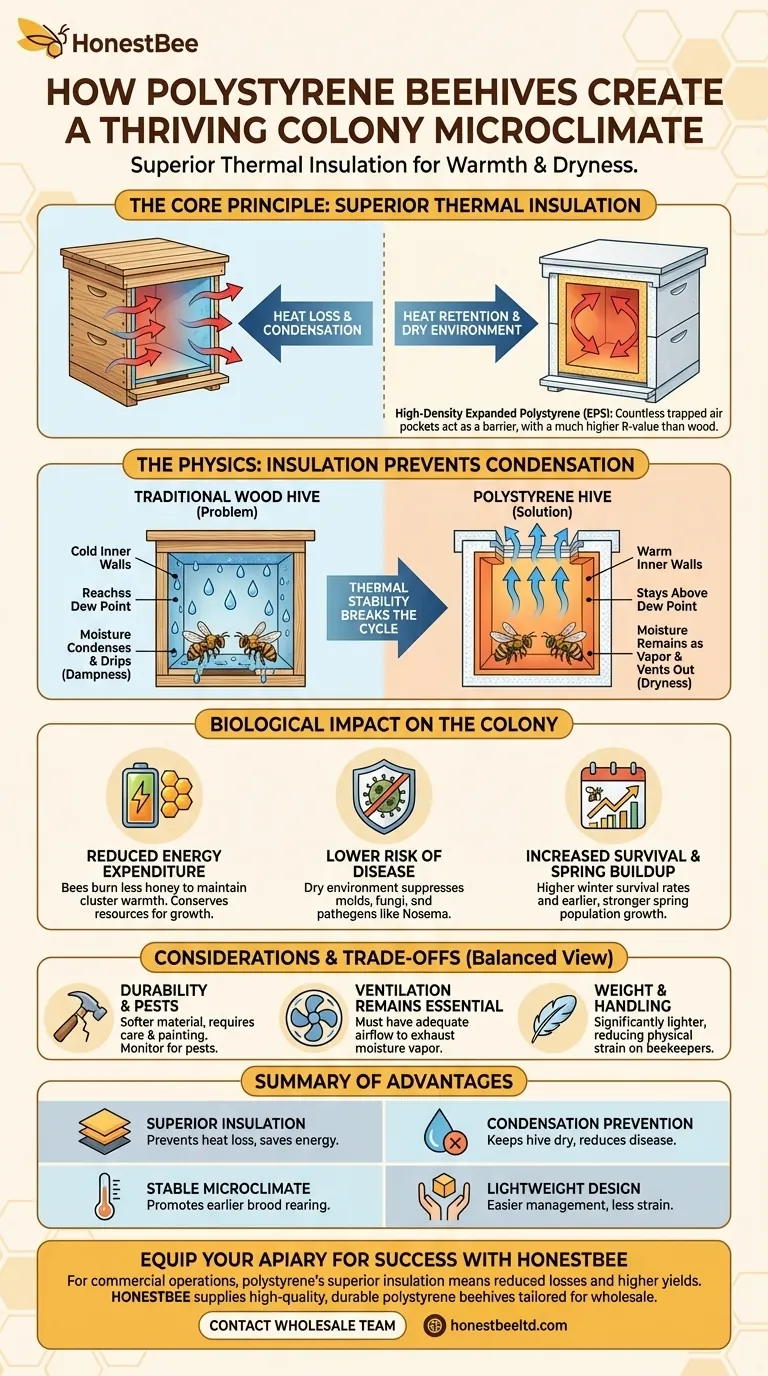At their core, polystyrene beehives maintain a warm and dry environment for honeybees through superior thermal insulation. Unlike traditional wood, high-density polystyrene is a poor conductor of heat, which prevents the hive's inner walls from becoming cold. This thermal stability stops the condensation of water vapor, keeping the colony dry and drastically reducing the energy bees must expend to stay warm.
The fundamental advantage of polystyrene is its ability to create a stable microclimate. This stability minimizes temperature and moisture stress on the colony, directly translating to lower energy consumption, reduced disease risk, and higher winter survival rates.

The Physics of Hive Climate Control
To understand why polystyrene works, we must first look at the core environmental challenges inside any beehive: heat loss and moisture management.
The Problem in Traditional Wood Hives
A honeybee colony generates significant heat and water vapor as byproducts of its metabolism. In a wooden hive, which has relatively poor insulation, this heat escapes quickly through the walls and roof.
As the warm, moist air from the bee cluster contacts the cold inner surfaces of the hive, the moisture condenses into liquid water. This condensation can drip down onto the bees, causing chilling and creating a damp environment ripe for disease.
How Polystyrene Solves the Insulation Problem
Polystyrene, particularly high-density Expanded Polystyrene (EPS), is composed of countless tiny pockets of trapped air. This structure makes it an extremely effective insulator, with a thermal resistance (R-value) many times higher than that of solid wood.
Think of it as the difference between a single-walled metal cup and a modern insulated thermos. The thermos keeps the contents hot not just by holding heat, but by preventing the outside temperature from affecting the inner wall. A polystyrene hive does the same for the bee colony.
The Critical Link Between Insulation and Moisture
This superior insulation directly prevents condensation. Because the inner walls of a polystyrene hive stay close to the internal hive temperature, they never get cold enough to reach the dew point—the temperature at which water vapor turns back into liquid.
Instead of condensing and dripping on the bees, the water vapor remains in the air and is properly exhausted through the hive's ventilation system. The result is a consistently warm and, most importantly, dry internal environment.
The Biological Impact on the Colony
This stable, dry climate has profound and direct benefits for the health and productivity of the honeybee colony.
Reduced Energy Expenditure
Bees do not heat the entire hive cavity; they heat their cluster. In a cold, damp, and poorly insulated hive, the cluster must burn through enormous amounts of stored honey simply to maintain its core temperature of around 95°F (35°C).
In a polystyrene hive, the insulation dramatically reduces this heat loss. The colony can therefore dedicate far more of its energy and food resources toward brood rearing and population growth, rather than just survival.
Lower Risk of Disease
Moisture is a primary enabler of bee diseases. A damp hive promotes the growth of harmful molds and fungi and can exacerbate conditions like Nosema, a serious gut pathogen.
By keeping the colony dry, polystyrene hives create an environment that is inherently healthier and suppresses the proliferation of these threats, increasing the colony's overall longevity and resilience.
Increased Survival and Spring Buildup
The combined effects of reduced energy stress and lower disease pressure lead to a significantly higher rate of winter survival.
Furthermore, colonies emerging from winter are stronger and have more resources. The stable warmth encourages the queen to begin laying earlier in the spring, leading to a more rapid population buildup and a more productive colony for the season ahead.
Understanding the Trade-offs
While thermally superior, polystyrene is not without its considerations. An objective evaluation requires acknowledging its limitations.
Durability and Pests
Polystyrene is softer than wood and can be damaged by hive tools if the beekeeper is not careful. It can also be susceptible to damage from pests like wax moths or ants if the hive is not kept strong and clean. Most polystyrene hives require a coat of exterior latex paint to protect them from UV degradation.
Ventilation Remains Essential
Excellent insulation is not a substitute for proper ventilation. A polystyrene hive still requires adequate airflow, typically an open entrance and often a top vent, to allow the moist air generated by the bees to escape. A completely sealed insulated box would trap moisture and create a new set of problems.
Weight and Handling
On the positive side, polystyrene hives are significantly lighter than their wooden counterparts. This makes them much easier to lift and manage, a major benefit for beekeepers with physical limitations or those who need to move their hives frequently.
Making the Right Choice for Your Goal
Ultimately, the choice between polystyrene and wood depends on your specific climate, goals, and beekeeping style.
- If your primary focus is maximizing winter survival in a cold climate: Polystyrene's superior insulation offers a decisive advantage in reducing colony losses and ensuring a stronger start in the spring.
- If your primary focus is a traditional aesthetic with maximum durability: A well-managed wooden hive is a proven tool, but you must be more vigilant about moisture control and may need to add insulation wraps for winter.
- If your primary focus is ease of handling and reduced physical strain: The lightweight nature of polystyrene hives makes them a far more manageable and ergonomic choice.
By understanding the thermal dynamics of your hive, you empower yourself to create an environment where your colony can truly thrive.
Summary Table:
| Advantage | How Polystyrene Achieves It | Benefit for the Colony |
|---|---|---|
| Superior Insulation | High R-value from trapped air pockets prevents heat loss through walls. | Drastically reduces energy bees expend to stay warm, conserving honey stores. |
| Condensation Prevention | Inner walls stay warm, avoiding the dew point where moisture condenses. | Creates a dry environment, suppressing mold, fungi, and diseases like Nosema. |
| Stable Microclimate | Maintains consistent internal temperature regardless of external conditions. | Promotes earlier spring brood rearing, leading to stronger, more productive colonies. |
| Lightweight Design | Material is significantly lighter than traditional wood. | Easier for beekeepers to lift and manage, reducing physical strain. |
Equip Your Apiary for Success with HONESTBEE
For commercial apiaries and distributors, colony health is directly tied to productivity and profitability. The superior insulation of polystyrene beehives is a proven method to reduce winter losses, accelerate spring buildup, and maximize honey yields.
HONESTBEE supplies high-quality, durable polystyrene beehives and a full range of beekeeping supplies tailored for wholesale and commercial operations. Our equipment is designed to help your colonies thrive in challenging climates, ensuring a stronger return on investment.
Contact our wholesale team today to discuss bulk pricing and how our solutions can strengthen your operation.
Visual Guide

Related Products
- Telescopic Beehive Outer Cover Lid Roof with Galvanised Sheeting for Langstroth Hive and Beehive Outer Cover
- HONESTBEE Advanced Ergonomic Stainless Steel Hive Tool for Beekeeping
- Professional Galvanized Hive Strap with Secure Locking Buckle for Beekeeping
- Professional Drop-Style Hive Handles for Beekeeping
- Professional Hive Top Bee Feeder for Beekeeping
People Also Ask
- What is the function of the top cover in a Langstroth hive? Master Hive Protection & Climate Control
- What are the two primary lid styles for Langstroth style beehives? Choose the Right Protection for Your Hives
- How do you install the Langstroth hive roof? A Step-by-Step Guide for a Healthy Colony
- What are the features of the peaked roof in Langstroth hives? Superior Weather Protection & Stability
- What is a telescoping outer cover and what are its advantages? Maximize Hive Protection in Harsh Climates



















